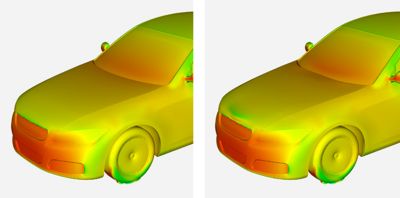-
United States -
United Kingdom -
India -
France -
Deutschland -
Italia -
日本 -
대한민국 -
中国 -
台灣
-
Ansys는 학생들에게 시뮬레이션 엔지니어링 소프트웨어를 무료로 제공함으로써 오늘날의 학생들의 성장을 지속적으로 지원하고 있습니다.
-
Ansys는 학생들에게 시뮬레이션 엔지니어링 소프트웨어를 무료로 제공함으로써 오늘날의 학생들의 성장을 지속적으로 지원하고 있습니다.
-
Ansys는 학생들에게 시뮬레이션 엔지니어링 소프트웨어를 무료로 제공함으로써 오늘날의 학생들의 성장을 지속적으로 지원하고 있습니다.
ANSYS BLOG
November 5, 2019
Aerodynamic Car Body Shape Optimizations & Design
Automotive engineers know the challenges of aerodynamic shape optimization. Some parts of the car body design are notoriously difficult to aerodynamically optimize, like a side mirror, because they have complex shapes that need to enclose mechanical components of a fixed size.
The Ansys Fluent adjoint solver is able to optimize the shape of components that are difficult for an engineer to optimize manually. Here, the adjoint solver is showing areas that can be morphed to improve the car's drag.
To keep a competitive edge, and to meet market demands, engineers need tools that can automate and simplify the shape optimization of car body designs.
How to Automate Shape Optimization of Car Body Designs
Engineers can use the Ansys Fluent adjoint solver to automate shape optimizations — especially those hard to optimize components.
In this case, engineers need to set up a computational fluid dynamics (CFD) simulation and state that the optimization goal is to reduce the drag of the car body design. The adjoint solver then automatically morphs the geometry and mesh of the design, based on previous iterations, to improve the aerodynamic performance.
To demonstrate the capabilities of the adjoint solver, engineers used it to optimize the shape of one of the most complex, and challenging, parts of the car to aerodynamically design — the side mirror.
The Ansys Fluent adjoint solver automatically updated the hood
geometry to reflect the recommended changes to reduce the drag.
These tests were performed on the DrivAer geometry from the Technical University of Munich.
Small features, mechanisms and mirrors need to fit into the side mirror enclosure without negatively affecting the rest of the car’s aerodynamics.
The position of side mirrors is rather set. They tend to fit on the car’s A-pillar to improve aerodynamics and a driver’s ability to adjust the view. To improve the aerodynamics, engineers need to conduct a shape optimization of the side mirror’s enclosure.
After only two iterations, the adjoint solver automatically morphed the geometry of the side mirror’s enclosure to improve the drag coefficient from 0.299 to 0.286. That represents an improvement of 13 automotive drag counts (or 130 drag counts in the aerospace industry).
Adjoint Solver Optimizes the Shape of Car Body Designs Where it’s Least Expected
There can be areas of a car body design that an engineer may not think to examine to improve the aerodynamics.
Baseline pressure (left) compared to improved pressure (right) after the Ansys Fluent adjoint solver optimized the geometry of the
hood to reduce the drag coefficient.
For instance, a car’s hood is a large, smooth surface that doesn’t typically add much drag. To save time, many shape optimization specialists focus on more problematic areas.
However, with the adjoint solver, another test showed that changing the geometry of the hood could reduce the car’s drag coefficient, by another 4%, by changing from 0.299 to 0.287, or 12 automotive drag counts (120 drag counts in the aerospace industry).
To learn how to speed up shape optimization using an automated and customizable workflow within Ansys Fluent, join the webinar: Ansys 2019 R3: Fluent Adjoint Solver Update.













